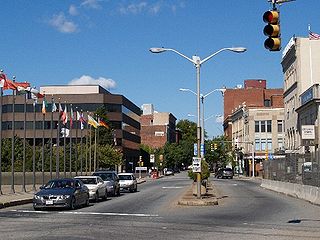
Fall River is a city in Bristol County, Massachusetts, United States. The City of Fall River's population was 94,000 at the 2020 United States Census, making it the tenth-largest city in the state.
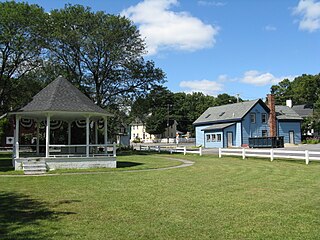
Assonet is one of two villages in the town of Freetown, Massachusetts in Bristol County, Massachusetts, United States. An original part of the town, Assonet was settled in 1659 along with the city of Fall River, then a part of Freetown. It rests on the banks of the Assonet River. As of the 2000 census, the village had a total population of 4,084; up from 3,614 in 1990. As of the 2014 census the village had a total estimated population of 9,093.

For much of its history, the city of Fall River, Massachusetts has been defined by the rise and fall of its cotton textile industry. From its beginnings as a rural outpost of the Plymouth Colony, the city grew to become the largest textile producing center in the United States during the 19th century, with over one hundred mills in operation by 1920. Even with the demise of local textile productions during the 20th century, there remains a lasting legacy of its impact on the city.

Fall River granite is a Precambrian bedrock underlying the City of Fall River, Massachusetts and surrounding areas along the eastern shores of Narragansett Bay. It was formed 600 million years ago, as part of the Avalon terrane.

The Border City Mill No. 2 is a historic cotton textile mill at One Weaver Street in Fall River, Massachusetts. Built in 1873, it is the largest surviving element of the once-sprawling Border City Mill complex. It was designed by Josiah Brown, a prominent local designer of mills, and is one of the city's few brick mills. It was listed on the National Register of Historic Places in 1990. It was converted into residences in the 1980s.

Chace Mills is a historic textile mill complex on Lewiston and Salem Streets in Fall River, Massachusetts. Built in 1872, it is one of the city's most visible historic mills, with a particularly fine Italianate stair tower. The complex was added to the National Register of Historic Places in 1983.

Narragansett Mills is an historic textile mill site located at 1567 North Main Street in Fall River, Massachusetts, United States. Built in 1872, it is a well-preserved example of a brick mill complex, somewhat unusual in a city where most of the mills are stone. It was listed on the National Register of Historic Places in 1983.

Stafford Mills is an historic textile mill complex located on County Street in Fall River, Massachusetts, USA. Founded in 1872, it is a well-preserved late-19th century textile complex, typical of the mills built in Fall River during its period of most rapid growth. It is noted in particular for its exceptionally fine Romanesque brick office building. The complex was added to the National Register of Historic Places in 1983.

Durfee Mills is an historic textile mill complex located at 359-479 Pleasant Street in Fall River, Massachusetts, USA. Developed between 1866 and 1904, it was during its period of development the city's largest and architecturally finest mill complex. Along with the adjacent Union Mills, it is occupied by numerous retail businesses and a restaurant, and is known as the Durfee-Union Mills. The complex was listed on the National Register of Historic Places in 1983.
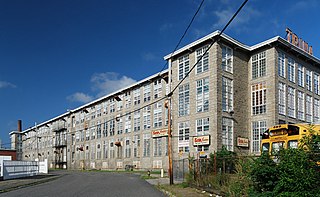
Sagamore Mills No. 1 and No. 3 are two historic textile mills on Ace Street in Fall River, Massachusetts. Built in 1888 and 1908, they form part of one of the city's single largest textile operations of the late 19th century. Mills No. 1 and 3 were added to the National Register of Historic Places in 1983, with a separate listing for Mill No. 2, located nearby on North Main Street.

Barnard Mills is an historic mill at 641-657 Quarry Street in Fall River, Massachusetts. Developed beginning in 1874, it was the first mill to use ring spinners instead of mule spinners, and was a major local employer until its closure in 1939. The complex has been redeveloped as a commercial retail space called Tower Mill. The mill was added to the National Register of Historic Places in 1983.
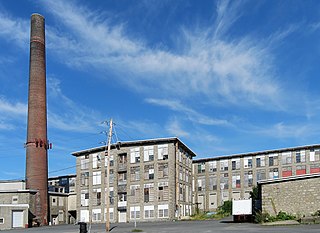
Charlton Mill is a historic textile mill at 109 Howe Street in Fall River, Massachusetts. Built in 1911, it is the last of the city's stone mill buildings to be built, and the first to feature the dual sources of steam and electrical power. The mill was added to the National Register of Historic Places in 1983.

Crescent Mill, later Merchant Mill No. 3, is an historic cotton textile mill located at 54 Front Street in Fall River, Massachusetts. Built in 1872 during an industrial construction boom, it is one of the city's finest examples of Italianate mill architecture. The building was added to the National Register of Historic Places in 1983. It is now used for other light industrial purposes.
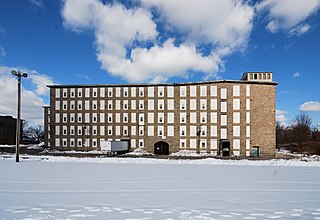
Flint Mills is a historic textile mill complex located on Alden Street in Fall River, Massachusetts, near the banks of the Quequechan River. The company was founded in 1872 and named in honor of John D. Flint, who served as its first president. The original 1872 mill burned in 1882, and was rebuilt in 1883. The complex was later expanded with a second mill and large addition in 1909. The site also contains a detached granite mill office building. The section of Fall River surrounding the mill became known as "Flint Village". The site was added to the National Register of Historic Places in 1983.

King Philip Mills is an historic cotton mill complex located at 372 Kilburn Street in Fall River, Massachusetts. Developed between 1871 and 1892, it was historically one of the city's largest mills, and its building inventory is still largely complete. The complex was added to the National Register of Historic Places in 1983.
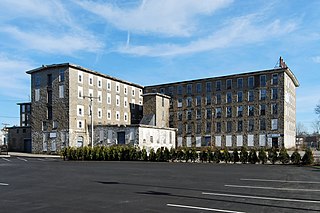
Wampanoag Mills is a historic textile mill complex located at 420 Quequechan Street in Fall River, Massachusetts. Built beginning in 1871, it is a large and well-preserved example of granite textile mill construction. The site was added to the National Register of Historic Places in 1983.

Cornell Mills is an historic cotton textile mill on Alden Street in Fall River, Massachusetts. Built in 1890, it is a well-preserved example of late 19th-century industrial mill architecture in stone. The mill complex was added to the National Register of Historic Places in 1983. On February 26, 2016, a developer has bought the property with the intent to convert the mill into middle-class residential housing.

Pilgrim Mills is an historic textile mill located at 847 Pleasant Street in Fall River, Massachusetts. The mill was built in 1911 from red brick and was the first mill in the city powered entirely by electricity, provided from the local grid. It was one of the last mill complexes built in the city. The property was listed on the National Register of Historic Places in 1983.

Tecumseh Mill No. 1 is a historic cotton mill located at 164 Hartwell Street in Fall River, Massachusetts. It was built in 1866, and added to the National Register of Historic Places in 1983 as part of the Corky Row Historic District. Tecumseh Mills No. 2 and No. 3 were located nearby on Plymouth Avenue, but have since been demolished.

The Cocheco Mills comprise a historic mill complex in the heart of Dover, New Hampshire. The mills occupy a bend in the Cochecho River that has been site of cotton textile manufacturing since at least 1823, when the Dover Manufacturing Company supplanted earlier sawmills and gristmills. The present mill buildings were built between the 1880s and the early 20th century, and were listed on the National Register of Historic Places in 2014.























